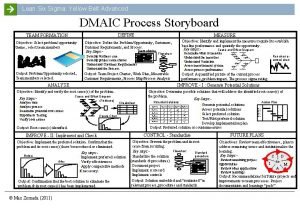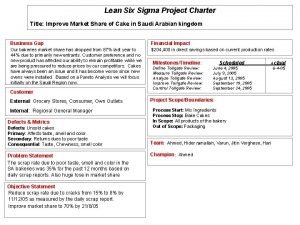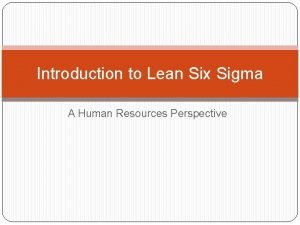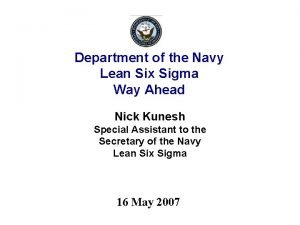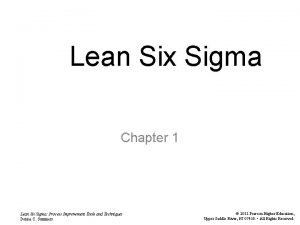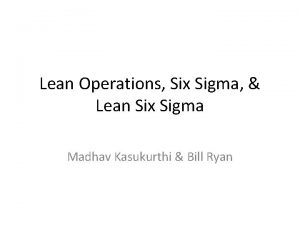Lean Six Sigma Executive Introduction Competition Serious Competition






- Slides: 6

Lean Six Sigma Executive Introduction

Competition Serious Competition! Every morning in Africa, a gazelle wakes up; it knows it must run faster than the fastest lion or it will not survive. Every morning in Africa, a lion wakes up; it knows it must outrun the slowest gazelle or it will starve. It doesn’t matter whether you are a lion or a gazelle: When the sun comes up, you had better be running! Lean Six Sigma Executive Introduction Copyright Open. Source. Six. Sigma. com

Course Overview Course Purpose This course has been developed to create an awareness of the means of deploying and the impact of a Lean Six Sigma initiative as a Business Process Improvement program. Course Goal The goal of this training is to: a) Increase your understanding of Lean Six Sigma techniques as business process improvement methodologies. b) Assist you in assessing the impact such as a program may have for your company. c) To gain an understanding of the role you, as management, must undertake to achieve the greatest level of business success. Personal Results After successfully completing this course you will have enhanced your knowledge of process functionality, analytical skills, problem solving skills and methods for increasing the efficiency, effectiveness and adaptability of the organization you manage. Lean Six Sigma Executive Introduction Copyright Open. Source. Six. Sigma. com

Objectives for You as a Participant 1. Obtain an understanding of a Lean Six Sigma program objectives - Know and comprehend the impact the concepts can have on your business - Become familiar with the terminology 2. Comprehend daily work as a process-oriented activity - Understand process inputs and outputs - Understand process flow and know what determines value add vs. non-value add 3. Understand how the processes you manage fit into the larger set of processes needed in delivering value to the customer - Grasp the power of Process Mapping and characterization - Recognize significant outputs and quantify their level of performance to requirements - Identify inputs and their relationship to the significant outputs - Link key processes to the strategic objectives of the company 4. Establish control mechanisms and monitoring processes to sustain an existing process and improvements you make. 5. Prepare to implement a Lean Six Sigma - Determine the structure of such a program for your company - Learn to identify “projects”, prioritize them and link them to corporate strategy Lean Six Sigma Executive Introduction Copyright Open. Source. Six. Sigma. com

Defining Lean Six Sigma So, what is Lean Six Sigma? At a high level, Lean Six Sigma is an approach to improving the performance of your company through the practice of the disciplines of Lean and Six Sigma. Lean: The application of principles whose objective is to eliminate WASTE while improving process flow to achieve speed and agility at lower cost. Six Sigma: The application of principles whose objective is eliminate DEFECTS and VARIATION. (We will see later why Variation is bad… very, very bad!) These principles are applied through a system of Process Management. When combined and effectively applied, major improvements are achieved in business performance. Lean Six Sigma Executive Introduction Copyright Open. Source. Six. Sigma. com

Team Work as a Process Member Team Work The majority of the process improvement efforts will be undertaken by teams of people. The skill levels of the team members may vary significantly yet each will contribute. There are numerous benefits to the use of teams: a) Broader range of input relative to the subject process b) Sharing of the workload to assure project stays on track c) Buy-in by all those impacted by or impacting the project d) Opportunity to better sustain the improvement with impacted personnel buy-in e) Greater employee satisfaction through participation and subsequent recognition and sense of contribution f) Learning opportunity for those working with personnel trained to more sophisticated level of Lean Six Sigma Go Team!! Lean Six Sigma Executive Introduction Copyright Open. Source. Six. Sigma. com


